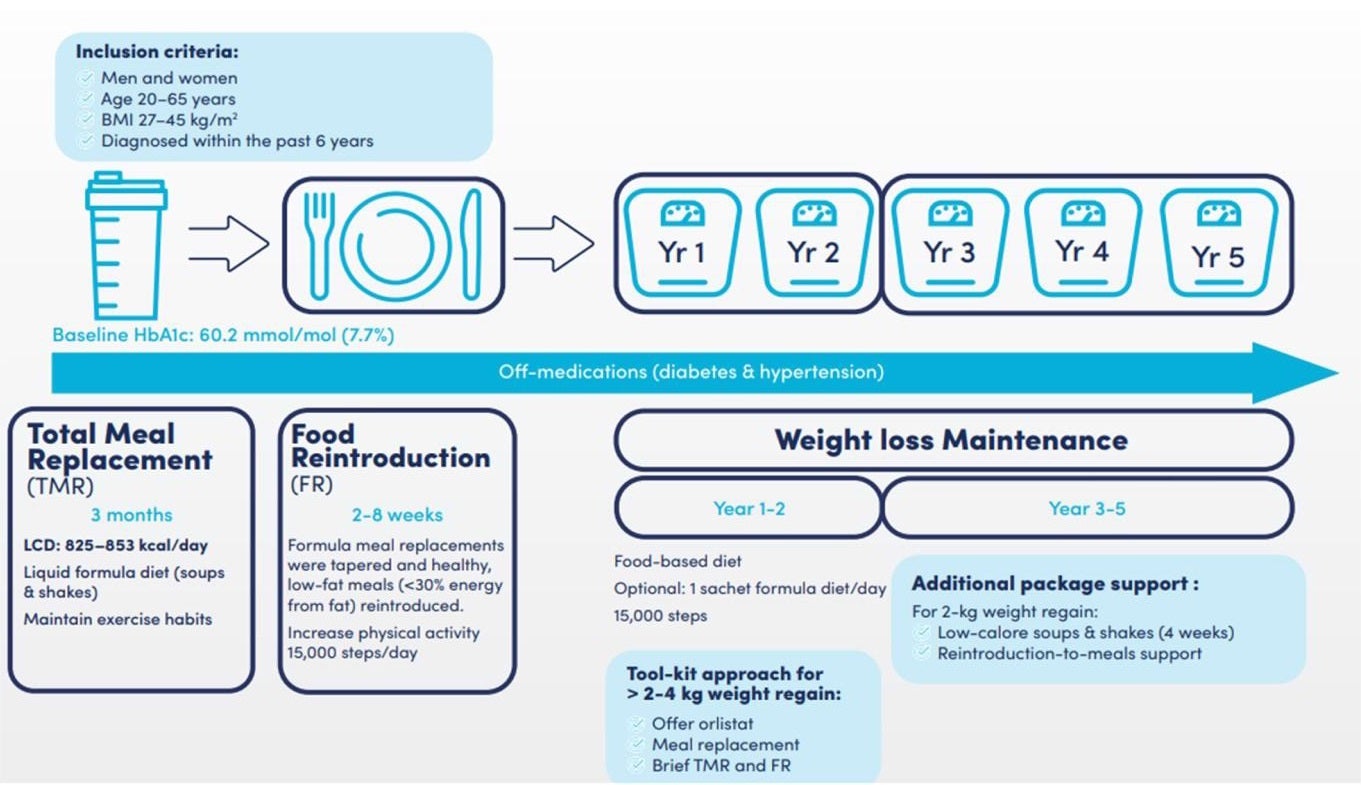Signs of Recovery in Diabetes
Can type 2 diabetes be cured? The answer is yes. Type 2 diabetes (T2D) is traditionally recognized as a chronic disease with lifelong treatment. Yet, new evidence now shows remission is possible using evidence-based nutritional and weight loss therapy. One of the main signs of recovery in diabetes is, achieving HbA1c levels below 6.5% (<48 mmol/mol) for at least three months without the use of antidiabetic medications.1 The following studies illustrate the evidence that supports achieving remission in T2D.
Evidence-Based Diabetes Remission
One of the most influential trials exploring diabetes remission through weight loss is the DiRECT Study.
The DiRECT Study (UK)
The Diabetes Remission Clinical Trial (DiRECT) was conducted in primary care settings in Scotland and Tyneside, England1. To understand the impact of weight loss on diabetes remission, the DiRECT trial included participants aged 20–65 with T2D and with a BMI of 27–45 kg/m².1
The DiRECT Study Design:
The intervention that was implemented was total diet replacement (825–853 kcal/day) for 3–5 months followed by structured food reintroduction, and long-term weight maintenance. Antidiabetic and antihypertensive medications were withdrawn at the study’s start.1
Figure1 illustrates the DiRECT study’s complete protocol.

The DiRECT Study Results:
The most important result was that 46% of the intervention group experienced diabetes remission at 12 months, compared with 4% in the control group. For optimal results, a weight loss ≥15 kg was linked to an 86% remission rate. At the same time, there were significant reductions in triglycerides and blood pressure which are linked with better cardiovascular health. Figure 2 shows the UK DiRECT study results of diabetes remission rates and HbA1c levels at year 1.1

The DiRECT Study (UK) 5-Year Follow-Up
One of the biggest concerns in diabetes remission is whether patients can maintain their weight loss and remission over several years. So, the DiRECT 5-year follow-up evaluated the long-term sustainability of weight loss, remission, and health outcomes.2
The 5-year follow-up DiRECT Study Key Findings:
Weight Loss and Maintenance:
Year 1: In 12 months, 46% of patients achieved diabetes remission with an average weight loss of 10 kg in the intervention group.
Year 2: 36% achieved remission
Year 5: 23% Achieved remission after 5 years with an average weight loss of 8.9 kg in remission patients.2
Figure 3 shows that at 5 years, 23% of the intervention group achieved and maintained remission of diabetes, compared to 3.4% in the control group. Sustained remission was closely linked to long-term weight loss maintenance with an average weight loss of 8.9 kg (8.8% of baseline weight) among those in remission.2

Medication Reduction:
Intervention participants stopped glucose-lowering medications for 62% of follow-up duration in contrast to only 30% for control.2
Adverse Events:
- Adverse event rates in the intervention group were half the rates of the control group.2
- In conclusion, structured weight control interventions yield long-term remission and improved glycemic control, showing the feasibility of adopting similar programs in routine diabetes care.1,2
The DiRECT-Aus Study (Australia)
Would similar results be observed in different healthcare systems and populations? The DiRECT-Aus trial adapted the UK’s DiRECT methodology to an Australian primary care setting.3
The DiRECT Study (Australia) Study Design:
- Participants: Adults aged 20–65 with T2D for up to 6 years and a BMI >27 kg/m².
- Intervention: Low-energy diet replacement (800-950 kcal/day) with subsequent structured food reintroduction and weight maintenance phases.3
The DiRECT Study (Australia) Results:
- The findings from DiRECT-Aus closely mirrored those of DiRECT UK, reinforcing that structured weight management programs are effective across different populations.
- 56% of patients entered remission, with 87% success in those who had lost ≥15% of body weight. Mean weight loss at 12 months was 8.1%, with corresponding reductions in liver size (35%) and visceral fat (24%). The success of DiRECT-Aus highlights the applicability of structured weight loss programs.3
Additional Metabolic Benefits of Weight Loss Beyond Glycemia and Hemoglobin A1c
The DiRECT studies also demonstrated that blood lipids improved, too, in the forms of reduced levels of triglyceride and an increase in HDL cholesterol, each of which is associated with improved heart health. In addition, large declines in systolic and diastolic blood pressure are associated with lower hypertension-related risk. In sum, the DiRECT trials demonstrate the broader benefit of structured programs of weight loss, which is beyond improvements in blood glucose.1-3
Conclusion
The outcomes of the DiRECT trials demonstrate that controlled programs of weight reduction have excellent metabolic benefit in addition to lower glycemia and improvements in HbA1c. In fact, long-term weight reduction of 10–15 kg is accompanied by lasting remission of diabetes and a reduction in drug reliance. For healthcare professionals, this means rethinking diabetes treatment— from lifelong medication management to one that considers remission as a realistic goal.1-3
Learn more about the Science behind Diabetes Specific Food.
Click HereReferences
- Lean ME, et al. Lancet. 2018;391:541-51.
- Lean ME, et al. Lancet Diabetes Endocrinol. 2024;12:233-46.
- Hocking SL, et al. Diabetes Care. 2024;47:66-70.
Can type 2 diabetes be cured ? The answer is yes. Type 2 diabetes is traditionally recognized as a chronic disease that needs lifelong treatment. Yet, new evidence now shows remission is possible using an evidence-based nutritional and weight loss approach. Learn more about the clinical results of structured weight loss program based on the DiRECT and DiRECT-Aus studies.
